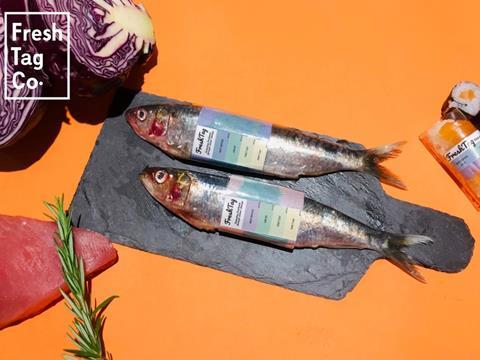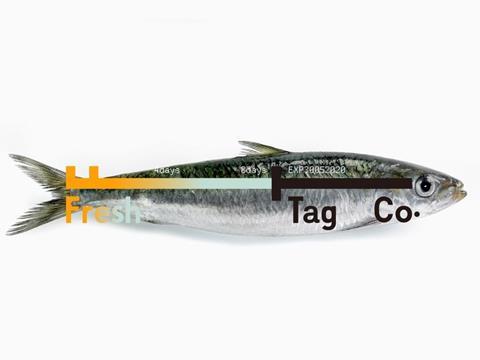
FreshTag is a pH-sensitive colour coding quality system that can be incorporated into a biofilm, ink, or label for food contact applications. As the freshness of the food product changes, so too does the colour of the FreshTag solution, giving consumers a clear indication of whether it is safe to eat. This means consumers do not have to rely on arbitrary ‘use by’ dates, thus reducing food waste and its associated environmental consequences.
We spoke to Rui Xu, the creator of FreshTag, about the technology’s development, potential, and future.

The hook: safer and more sustainable seafood consumption
Currently, FreshTag is focused on the domestic seafood market. According to a recent study, meat and fish waste has a significant environmental impact despite only accounting for around 10% of overall food waste across the supply chain. While WRAP found that 70% of food waste comes from households, many consumers cite issues with ‘use by’ dates – which are set by producers – as part of the reason why they throw away fish.
Xu elaborates on some of these issues: “the ‘use-by’ date offered by the producer is often underestimated and the actual viability period of the product varies hugely depending on many other factors such as storage conditions (temperature, humidity), condition of the packaging, as well as individual variation of the products.”
Where the fish is purchased from is also a factor. Local fishmongers, for example, are less likely to pre-pack fish than larger retailers – “leaving customers to guess the freshness if they do not consume the food immediately,” according to Xu.
In addition, the freshness of a product is likely to change when the packaging is opened, and it is exposed to oxygen or external contaminants. “This usually leads to an accelerated decay of the food,” Xu notes, which can invalidate the ‘use by’ date days before it actually arrives.
This is when FreshTag can provide reassurance and guidance for consumers, especially as fish is a high-risk food when it comes to food poisoning.
“The mechanism behind the FreshTag indicator dynamically monitors and reports the biochemical and microbiological changes taking place within your food product,” Xu explains. “It precisely reports its current state of freshness, allowing consumers to track the change from Fresh to Best Before to Use-by with visual cues.”
Therefore, acting as an alternative to unreliable ‘use-by’ dates, FreshTag intervenes where food waste data suggests it is needed most: the household. It provides the consumer with real-time data on the freshness of their products, empowering them to make more accurate and individual decisions than producers.
The UN’s Food and Agricultural Organization (FAO) acknowledges that food waste is about more than just the food itself; the energy and resources used to source, transport, and package it are also lost, and not always reclaimed if the food is placed into waste rather than reprocessing streams. FreshTag helps to ensure that food intended for human consumption reaches this stage, which can have a tangible impact on the carbon footprint of consumers.
FreshTag also help consumers to save money associated with food waste, such as having to buy more food to compensate for wastage. Xu adds that FreshTag will appeal to consumers who, in terms of material benefits, are “keen on higher freshness and food quality” and “wish to store their food for a longer period of time”.
Simultaneously addressing food waste from multiple angles and with precision, FreshTag is a promising innovation for the sustainable packaging of fresh and environmentally sensitive food products like seafood.

A fresh perspective
The FreshTag innovation does not come directly from within the packaging industry, but rather through the UK’s higher education channel. For an industry like packaging, which is arguably dominated by an older generation of leaders, investors, and developers, innovations from beyond the mainstream could help to provide the novel and workable ideas essential for addressing issues like food waste.
“It is the responsibility of the new generation of talents to develop innovative technology and educate the public,” says Xu when discussing FreshTag’s origins at InnovationRCA – a scheme offering incubation, guidance on patents, and business support from the Royal College of Art, London, where Xu was a student.
Xu identifies her role as “a material innovation designer” with a “dream to combine science with art”. FreshTag certainly seems to achieve this, incorporating pH measurements into a clear and colourful food contact packaging that will appeal to consumers’ desire for both aesthetic design and responsible consumption. Meanwhile, for companies, the colour change label is customisable, which Xu claims will “assist brands in maintaining a loyal customer base” by maintaining on-shelf recognition and presence.
FreshTag is a testament to the importance of remining open to new talent and new spaces of development. The packaging industry could stand to benefit from investing in technologies from such backgrounds, helping to bring them to scale and making them available to the large customer base of existing companies. In turn, this can help to boost the positive environmental impacts of innovations like FreshTag.

What’s next?
According to Xu, “the next product iteration will incorporate natural preservatives as additional ingredients, added to the colour-change biofilm.
“The natural preservatives will contribute to the increase of food products’ shelf life and reduce the growth rate of certain micro-organisms.”
Xu also expresses intentions to expand FreshTag’s scope to other types of food and beverage packaging.















